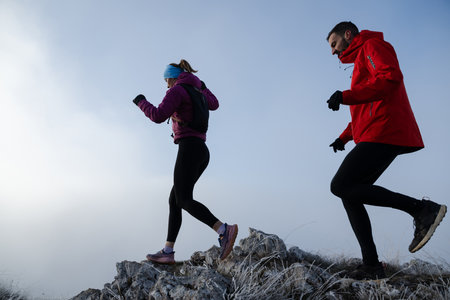1. Understanding the Challenges of Icy Trail Nutrition
Hiking on icy trails isn’t just about bundling up and keeping your footing—it also means paying close attention to what you eat and drink. Cold weather changes how your body works, especially when you’re trekking through snow and ice. Let’s break down how chilly conditions affect your metabolism, calorie burn, and even your appetite.
How Cold Weather Impacts Your Body
When temperatures drop, your body has to work harder to stay warm. This burns more calories than hiking in warmer conditions. As a result, you might need to fuel up more often, even if you don’t feel super hungry. Here’s a quick look at the main ways cold weather can impact your nutrition needs:
| Factor | Effect on Hikers |
|---|---|
| Metabolism | Increases as your body works to maintain core temperature |
| Caloric Burn | Higher due to shivering and extra effort walking on ice or snow |
| Appetite | May decrease, making it easy to forget to eat or drink enough |
The Science Behind Calorie Burn on Icy Trails
Your muscles need more energy when moving through snow or navigating icy patches. Plus, your body uses extra energy just to keep warm—think of it like your internal furnace running overtime. On top of that, even small tasks like setting up camp or taking off gloves can use more calories in the cold.
Why You Might Not Feel Hungry (But Still Need Fuel)
It’s common for hikers to notice their appetite drops in freezing temps. The cold can slow digestion and make food seem less appealing, but skipping meals can leave you low on energy fast. That’s why it’s important to plan snacks and meals ahead—even if you don’t feel very hungry at the time.
Key Takeaways for Managing Nutrition and Hydration
- Your body burns more calories on icy trails—be ready with extra snacks.
- You might not feel thirsty or hungry, but regular fueling is essential.
- Plan easy-to-eat foods that won’t freeze or become unappetizing in the cold.
Understanding these challenges is the first step toward staying energized and safe while exploring America’s beautiful frozen landscapes.
2. Smart Snack and Meal Planning for Cold Conditions
Why Cold Weather Changes Your Trail Food Strategy
When youre trekking icy trails, your body burns more calories to stay warm. On top of that, frigid temperatures can freeze your snacks solid or make meal prep a hassle. That’s why choosing the right foods—and packing them smart—is key for staying energized and safe.
Packing High-Energy Foods That Won’t Freeze
Focus on calorie-dense options with healthy fats, proteins, and carbs. Avoid foods with high water content since they freeze fast and become tough to eat. Here are some trail-tested tips:
- Go Nutty: Nuts, nut butters, and trail mixes stay soft in the cold and deliver tons of energy.
- Energy Bars: Choose bars designed for winter sports (like Clif Bars or RXBARs). Cut them into pieces before your hike so you won’t break a tooth if they get hard.
- Dried Fruits: Apricots, raisins, and mango are chewy, sweet, and dont freeze easily.
- Hard Cheeses & Summer Sausage: Both are American backcountry classics that stay edible even when temps drop.
- Tortillas over Bread: Tortillas won’t crumble or freeze as fast as regular bread.
Quick-Reference: Best Cold-Weather Trail Foods
| Food Type | Examples | Why It Works |
|---|---|---|
| Nuts & Seeds | Almonds, peanuts, pumpkin seeds | High fat/protein; don’t freeze easily |
| Energy Bars | Clif Bar, KIND Bar, RXBAR | Portable; cut up beforehand for easy eating |
| Dried Fruit | Cranberries, apricots, mango strips | Sugar boost; stays chewable in cold |
| Cheese & Sausage | Sharp cheddar, smoked gouda, summer sausage | Satisfying protein/fat; resists freezing |
| Tortillas/Wraps | Whole wheat tortillas, flour wraps | Easier to handle than bread in cold weather |
| Nutrient-Dense Snacks | Pepperoni sticks, jerky, chocolate bars (in moderation) | Savory or sweet energy; chocolate softens in pockets even if it gets cold |
Packing Tips for Icy Trails
- Pocket Storage: Keep snacks close to your body heat—in a jacket pocket—to prevent freezing.
- Ziploc Bags: Use small bags for quick access and portion control. Squeeze out excess air to save space.
- No-Cook Meals: Choose foods you can eat without heating up—no one wants to fumble with a stove when it’s icy!
- Add Variety: Mix salty and sweet snacks to keep your taste buds interested on long treks.
- Avoid Messy Foods: Leave gooey or crumbly items at home—frozen hands don’t manage sticky messes well.

3. Staying Hydrated When Water Turns to Ice
Why Hydration Matters on Icy Trails
When you’re hiking or climbing in icy conditions, staying hydrated can be a real challenge. Cold weather often makes us feel less thirsty, but your body still loses water through sweat, breathing, and even from the dry winter air. Dehydration can sneak up fast and affect your energy, focus, and warmth.
Strategies to Prevent Dehydration
- Drink Regularly: Don’t wait until you’re thirsty—sip water every 15–30 minutes, even if you don’t feel like it.
- Pre-hydrate: Drink extra water before hitting the trail to start ahead of the game.
- Add Flavor: Add electrolyte tablets or a splash of juice to make cold water more appealing.
- Monitor Your Urine: Pale yellow is good; dark means you need more fluids.
How to Keep Water Bottles from Freezing
| Method | Description |
|---|---|
| Insulated Bottle Holders | Use neoprene or foam sleeves to keep bottles warm inside your pack. |
| Bottle Placement | Cuddle your bottle close to your body’s core (inside your jacket or backpack). |
| Flip Bottles Upside Down | The top freezes last; this way you can still drink even if ice forms. |
| Start with Hot Water | Fill bottles with hot (not boiling) water before heading out. |
| Avoid Straws & Bladders | Tubes freeze quickly; stick with wide-mouth bottles for cold hikes. |
Packing Tip:
Wrap your bottles in extra clothing or stash them between layers in your pack for added insulation.
Recognizing Early Signs of Cold-Induced Dehydration
- Mild headache or dizziness
- Dry mouth and cracked lips
- Tiredness or sluggishness that sneaks up on you
- Lack of sweat despite hard work
- Dark-colored urine or not needing to pee as often as usual
If You Notice These Signs:
Stop for a break, drink some water, and have a quick snack. If symptoms persist, consider turning back—it’s better to play it safe in winter conditions!
4. Timing Your Food and Fluid Intake
Why Timing Matters on Icy Trails
When youre hiking or climbing in icy conditions, it can be easy to forget about eating and drinking. The cold often masks thirst and hunger cues, making it tempting to push on without regular breaks. However, your body is working hard to keep you warm and moving, so staying on top of nutrition and hydration is essential for energy, focus, and safety.
How Often Should You Refuel?
A good rule of thumb is to eat a small snack every 60–90 minutes and take a few sips of fluid every 20–30 minutes. Even if you don’t feel thirsty or hungry, stick to this schedule. Here’s a simple guideline:
| Activity Time | Food Intake | Fluid Intake |
|---|---|---|
| Every 60–90 min | Small snack (energy bar, trail mix) | – |
| Every 20–30 min | – | 2–4 sips of water or sports drink |
Tips for Remembering to Eat and Drink
- Set a timer: Use your phone or watch alarm as a reminder.
- Keep snacks handy: Store them in easy-to-reach pockets.
- Buddy check: Remind your hiking partners to take breaks together.
- Use insulated bottles: Prevent fluids from freezing by using insulated containers or stashing them inside your pack close to your body heat.
The Bottom Line on Timing
Maintaining consistent energy and hydration levels will help you stay alert and strong throughout your trek. Don’t wait until you’re exhausted or dehydrated—regular fueling keeps your adventure safe and enjoyable.
5. American Safety Precautions and Backcountry Etiquette
Food Storage: Keeping Wildlife and Yourself Safe
When hiking icy trails in the U.S., especially in national parks or remote backcountry, proper food storage is essential for both your safety and the safety of wildlife. In areas with bears, like the Rockies or the Sierra Nevada, use bear canisters or bear bags. Always store food and scented items (toothpaste, energy bars, drink mixes) at least 100 feet away from your sleeping area. Even on less remote trails, small critters like raccoons or squirrels can chew through packs, so hang your food or use hard-sided containers whenever possible.
| Storage Method | Best For | How-To |
|---|---|---|
| Bear Canister | Western U.S., bear country | Place all food inside; store 100 ft from camp |
| Bear Bag (hung) | Eastern U.S., some national forests | Hang bag 10-15 ft off ground, 4 ft from trunk |
| Hard-sided Container | Anywhere with rodents | Seal tightly and stash out of sight |
Leave No Trace: Respecting Americas Wild Places
The Leave No Trace principles are a big part of American hiking culture. When managing nutrition and hydration on icy trails, follow these core guidelines:
- Pack it in, pack it out: Carry out all trash, including wrappers, fruit peels, and used hydration packets.
- Avoid contaminating water sources: Never wash dishes or dispose of food waste directly in streams or lakes.
- No feeding wildlife: Keep all snacks secure; feeding animals changes their behavior and puts them at risk.
- Bury waste properly: If nature calls, dig a cat hole at least 6-8 inches deep and 200 feet away from water sources or trails.
Emergency Nutrition Supplies: Be Prepared for the Unexpected
Icy conditions can slow you down or force an unplanned overnight stay. American hikers often carry extra high-calorie foods as emergency rations—think energy bars, nut butters, jerky, or freeze-dried meals. Electrolyte tablets or powder packets are also smart to have if youre sweating under heavy layers. A basic breakdown for emergency food might look like this:
| Item | Why Its Good for Icy Trails |
|---|---|
| Energy Bars (high-calorie) | No prep needed; easy to eat with gloves on |
| Nuts & Nut Butters | Dense calories; protein and healthy fats for warmth |
| Jerky (beef/turkey) | Long shelf life; portable protein source |
| Sugar Candies/Gummies | Quick energy if you feel sluggish or cold |
| Electrolyte Tablets/Powders | Avoid dehydration in dry winter air; light to carry |
Packing Tips for American Trails:
- Keep one snack bar in a chest pocket to prevent freezing.
- If solo hiking, leave details of your route and expected return with someone trustworthy—standard backcountry etiquette.
- Certain public lands require a bear canister by law—check regulations before you go!
By following these American safety precautions and backcountry etiquette rules, youll help protect nature—and yourself—while enjoying snowy adventures on the trail.


